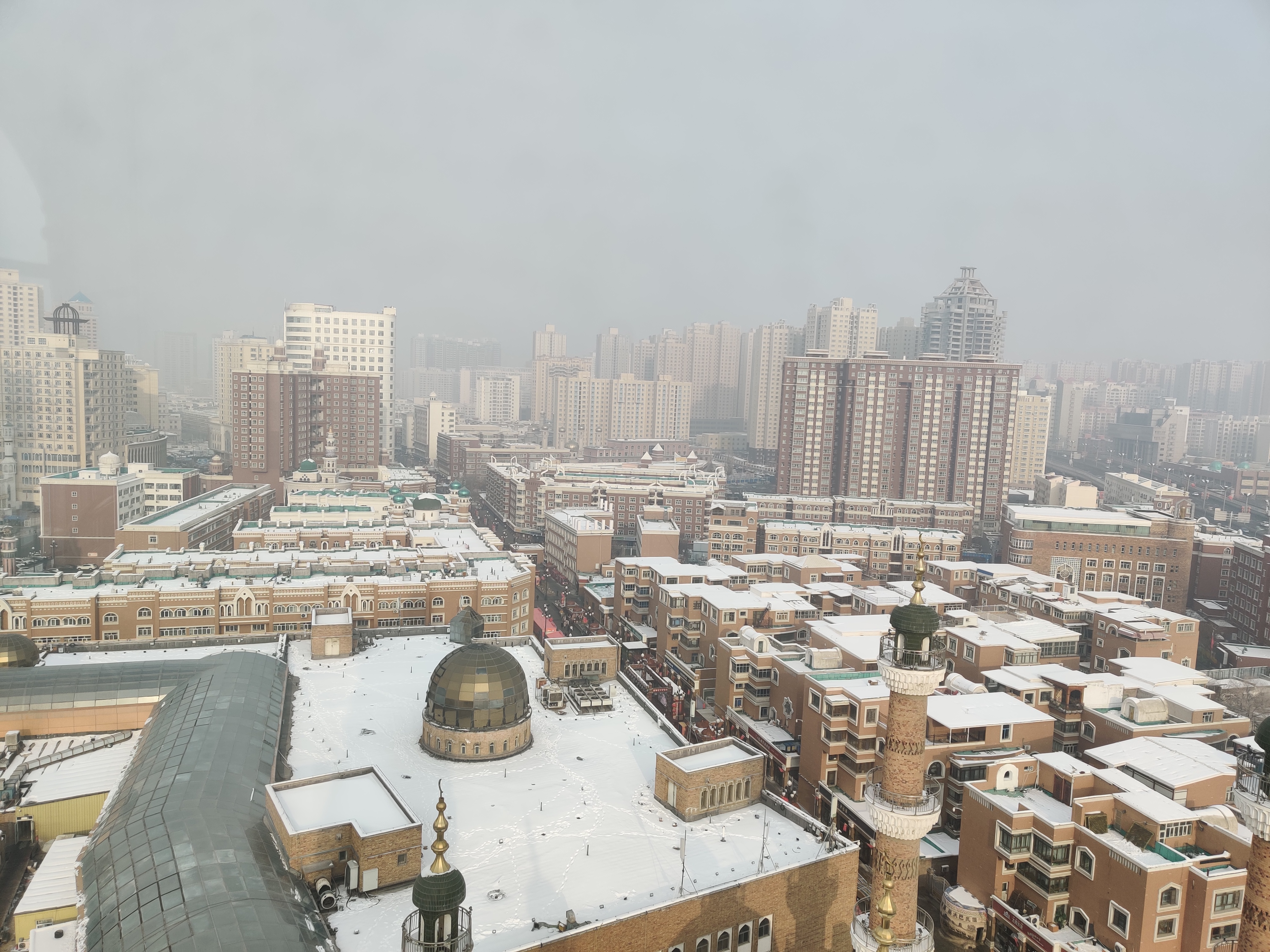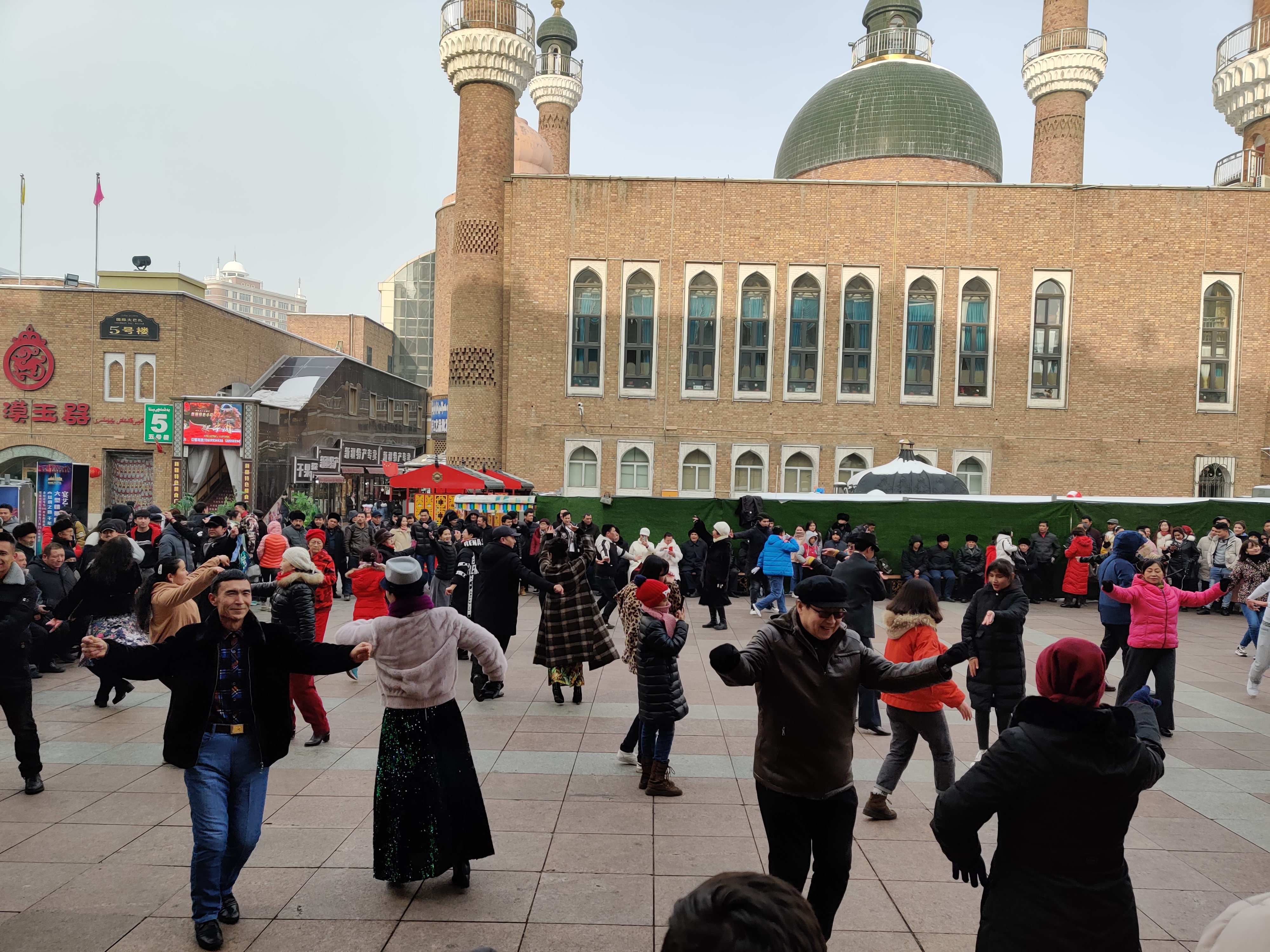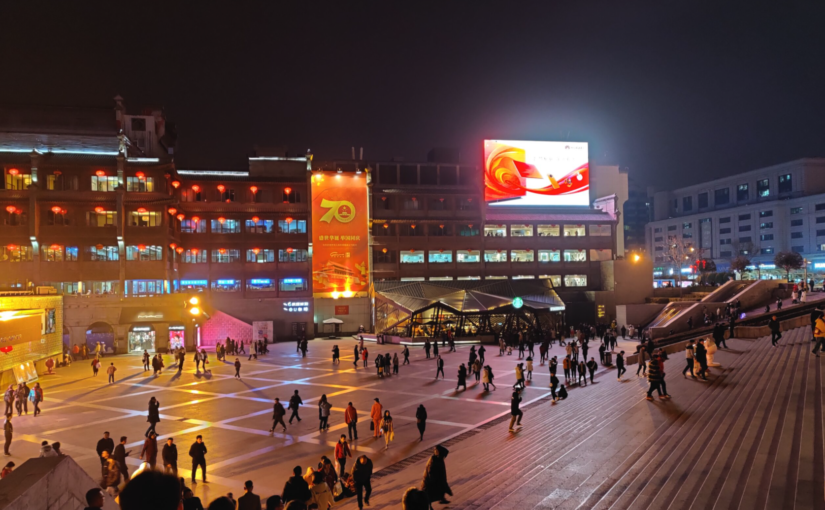Between 27 December and 7 January, I joined a China Silk Road Tour led by former US congresswoman Cynthia McKinney and organised by Chinese-American activist Lee Siu Hin. There were various strands of political ideology to be found among the 20 delegates, but we were united in our opposition to the growing US-led Cold War, which is directed primarily at China and which seeks to prevent the emergence of a multipolar world.
We spent around three days each in Beijing, Xi’an (capital of Shaanxi province, and one of the oldest cities in China), Dunhuang (a small oasis city that served as an important stop on the ancient Silk Road) and Ürümqi (capital of the Xinjiang Uighur Autonomous Region). China is enormous, but this itinerary – stretching across the north of the country – allowed us to develop some understanding of its diversity.
Housing
Walking around in Beijing, Xi’an, Dunhuang and Ürümqi, one thing that immediately strikes you is how clean, modern, safe and well-organised Chinese cities are. The metro is cheap, extensive, efficient, and easy to navigate. There are public toilets everywhere. The streets are spotless. People come across as friendly and confident. Remarkably, you don’t see beggars or people sleeping on the street. Those in the delegation who live in London or New York all commented on the contrast.
In meetings with the Chinese Academy of Marxism and the Beijing People’s Association for Friendship with Foreign Countries, we were able to find out more about the housing situation in China. Around 90 percent of Chinese families own their own homes (and the majority of these homes are owned outright, without a mortgage). The remaining 10 percent live in heavily subsidised social housing, or in accommodation provided to migrant workers by their employers. The latter group – migrant workers from rural areas – also benefit from the fact that the Chinese Revolution wiped out feudalism and the landlord system in the countryside, so if work dries up in the city, migrant workers have the option of going back to their land. As a result, there are none of the urban slums that are so commonplace in a lot of Asian countries.
The housing situation is by no means perfect – significant inequality has opened up, particularly between urban residents (who were able to buy their apartments at very low cost during the first phase of housing reform) and villagers and migrants; however, the government is working hard to resolve various housing-related problems: preventing speculation, liberalising the hukuo (household registration) system, building millions of units of low-cost social housing, and investing heavily in the development of smaller inland cities so as to even out the imbalance between the big East Coast cities and the rest of the country.
To basically solve the problem of homelessness in an enormous Asian country of 1.3 billion people is a remarkable accomplishment. It’s extremely difficult for most other countries in Asia and Africa – those that didn’t have thoroughgoing land revolutions – to meaningfully tackle homelessness. Meanwhile in the developed capitalist countries, the resources exist to address the problem, but the political system is built around the needs of the rich and therefore homelessness is simply never a priority. In short, it’s one of the huge socio-economic problems that only socialism has solved.
Addressing inequality
Housing inequality is connected to the broader issue of inequality between urban and rural areas, between coastal and inland zones, and between city residents and migrant workers. The Chinese development model in the 1980s and 1990s was based on allowing the major trading cities on the south-eastern coast to develop first, attracting foreign capital and new technology by offering a huge pool of low-cost, well-educated and diligent workers. Many of these workers were migrants – typically people in their 20s – who would come from the countryside because they could earn more in low-paid factory work than they could from their land (with 20 percent of the world’s population but only 6 percent of its arable land, overpopulation of the countryside has been an intractable problem in China for many centuries).
The migrant worker system is particularly attractive for foreign capital, because it means companies can base their pay scales on the costs of a single worker rather than a whole family, and because it’s consistent with seasonal or casual work (since migrant workers simply go back to the village when labour supply exceeds demand).
The Chinese government recognises that this system has fomented inequality and that the millions of migrant workers have benefitted far less from China’s rapid growth than most of the rest of the population. However, in a situation where it had practically zero capital and desperately needed to attract investment to develop its technology and integrate into the global economy, China had little choice but to implement pro-capital policies. From the late 1990s, China has had the material base to deliver much improved living conditions for all workers.
In terms of protecting the rights of migrant workers in the big cities, the two major policy strands are to mandate higher pay and better conditions, and to gradually replace the hukuo system with a residency permit that will allow long-term migrant workers access to the full range of rights and services provided to city residents.
The government is also pursuing a broader rebalancing strategy, promoting the development of smaller cities in the west, north and centre of the country. Towards this aim, there has been incredible infrastructure development over the last decade. The whole country is connected via high-speed rail and road. Modern energy is available everywhere, and internet access is practically universal. Although Xinjiang has historically been the poorest region of the country, we found it to be almost as modern and developed as Beijing, with good quality roads, 4G internet, plentiful housing, and a newly-opened metro system.
In Dunhuang, a small city of around 180,000 people, we travelled on the local network of electric buses, which run regularly through the city. We also happened upon the Gansu Dunhuang Solar Park, one of the big new industries in the area. It’s utterly enormous, with an annual net energy output of around 80 GWh. China was responsible for 32 percent of global renewable energy investment last year, and is increasingly recognised as the world leader in preventing climate catastrophe. Its move to green development fits perfectly with its rebalancing strategy, and solar parks and other alternative energy plants are being set up throughout the country.
We took the high-speed train from Beijing to Xi’an, and from Liuyuan (Gansu) to Ürümqi. The Beijing-Xi’an journey was cheap, comfortable and fast, taking a little over four hours to cover a distance approximately equal to that between New York City and Chicago – which journey would take at least 19 hours by train and cost several times more. China’s state-owned high speed rail network is by far the largest in the world; in fact it accounts for two-thirds of global HSR capacity. CRRC, the state-owned train manufacturer, is currently working on magnetic levitation trains that will travel at 600km/h – approximately twice the speed of current HSR.
China’s vision for the coming 20-30 years focuses on continuing this process of rebalancing, spreading prosperity throughout the country, and moving to a model of development that’s highly innovative, technological, ecological, localised and networked.
Air pollution
Many people associate China with terrifying levels of pollution. Our experience was that the air pollution in Beijing is noticeable but not terrible. Residents all say it’s improved massively in recent years. We learned at the Beijing People’s Association for Friendship with Foreign Countries that the current mayor of Beijing, Chen Jining, is an environmental engineer who got his PhD at Imperial College London and who was China’s environment minister from 2015 to 2017. He has been strongly focused on reducing air pollution and greenhouse gas emissions, and establishing Beijing as a global innovator in the fight against environmental catastrophe. One recent innovation has been to ban the purchase of internal combustion-based cars – that is, if you buy a new car, it has to run on new energy.
Similar processes are taking place throughout China, as the government tries to simultaneously tackle air pollution and greenhouse gas emissions. Although China’s rapid economic growth has been based in no small part on its abundant supply of cheap coal, coal takes up an ever-decreasing share of its energy mix (down from 80 percent to 60 percent in the last decade), and China is by far the biggest investor and innovator in solar and wind energy.
Mistreatment of Muslims
Western media has built a powerful narrative of Chinese oppression of its Muslim minority. Most notably, we’re told of the existence of ‘concentration camps’ in Xinjiang, where millions of people are denied their religious and human rights. The US House of Representatives recently passed the Uighur Human Rights Policy Act, calling for sanctions to be imposed against China because of the alleged detention of millions of Uighur Muslims.

Our delegation wasn’t a fact-finding mission; we didn’t have a specific aim to verify the truth of these various allegations. We did however walk freely around Ürümqi and the Muslim quarter in Xi’an, and failed to see any evidence of religious or ethnic oppression. In Ürümqi one sees mosques everywhere; indeed Xinjiang has one of the highest number of mosques per capita in the world. Walking well off the beaten track, we saw hundreds of Chinese Muslims, wearing their distinctive Uighur dress (including headscarves for many women) and going about their lives without any indication that they were living in fear of persecution. We ate in Uighur restaurants, in which halal food was served and alcohol wasn’t available.
What’s true is that the levels of security in Ürümqi are much higher than the other places we visited – you walk through metal detectors and have your bag x-rayed when going into any tourist spot, train station or major shopping area. This is a response to a wave of terrorist attacks conducted by al Qaeda-aligned groups since the 1990s. China has attempted to tackle terrorism through a holistic approach involving security, poverty alleviation and education. It is the latter part which has been most controversial within the western human rights community. Where China is attempting to tackle religious extremism with what it considers to be a fairly soft touch – requiring people to attend courses on religious tolerance (as opposed to, say, holding people captive for years on Guantanamo and subjecting them to vicious torture) – this has been portrayed as a system of arbitrary mass incarceration. Such far-fetched Cold War propaganda has been helpfully debunked by investigative journalists Ajit Singh and Max Blumenthal. The success of the anti-terrorism campaign is indicated by the fact that there hasn’t been a terror attack in Xinjiang for the last three years.

Human rights
Soon after the end of our trip, the news came out that Human Rights Watch executive director Kenneth Roth had been denied entry to Hong Kong, where he was planning to release a report “spotlighting Beijing’s deepening assault on international efforts to uphold human rights”. This led to a chorus of protests in the media about Chinese abuse of human rights.
One thing that’s fairly obvious as you travel around China and talk to ordinary Chinese people is that the Chinese government is very much focused on human rights. First and foremost among these is the right to life: to eat, to work, to get an education, to receive good quality healthcare, to live in a secure home, to enjoy leisure time, to pursue one’s interests. In terms of these crucial rights, no state in history has made as powerful a contribution as that of the People’s Republic of China – no state in history has lifted so many out of poverty, or provided education and housing for so many, regardless of gender, ethnicity, religion and income level. The enormous popularity of the Chinese government within China is down to its record in delivering on people’s needs. Meanwhile there’s very little demand for a western-style parliamentary system, because the particular configuration of political forces that prefigured the parliamentary system in the early days of European capitalism doesn’t prevail in China.
The activities of Human Rights Watch in relation to China must be considered in terms of the overall geopolitical situation. US capital is leading a ‘full-court press’ against China, with the aim of preventing (or at least decelerating) its rise. Ultimately the western capitalist countries would like to see the overthrow of the Chinese Communist Party government and its replacement with a regime that’s willing to put the Chinese people and resources at the service of multinational capital. They want a neo-colonial relationship with China, which ultimately would constitute a disastrous blow of untold proportions for the human rights of the Chinese people. This is the context of the ‘Pivot to Asia’, of Trump’s trade war, of the media frenzy about Xinjiang and Hong Kong, and of the endless reports issued by the likes of Kenneth Roth.
Say no to the New Cold War
While our delegation was in Gansu, on 3 January, we received the news that Iranian general Qasem Soleimani had been murdered by US forces in Iraq. This reckless and illegal act marks a significant escalation against Iran. It’s almost certainly not a coincidence that, just a few days previously, Iran, China and Russia launched their first joint naval exercises in the Gulf of Oman. An alliance of China, Russia and Iran – working closely with progressive Latin America, South Africa, Vietnam, Syria, Iraq, Belarus and others – is a real threat to US attempts to reassert its global dominance. Trump’s murder of Soleimani should therefore be seen not only as an attack on the people of Iran but on the entire multipolar project, on the right of nations to determine their own development paths.
With the new Cold Warriors going all out to demonise and undermine China, it’s more important than ever to build solidarity and friendship with the People’s Republic.


Congratulations. Your report is very much in line with my own findings.
I wrote an article, Through the Eyes of the Children. My argument was basically that the confidance and openness of the children had to reflect the feelings in the family home. China is on a roll, the people know it and are proud and very supportive of their leaders, direction, and achievements.
Well done